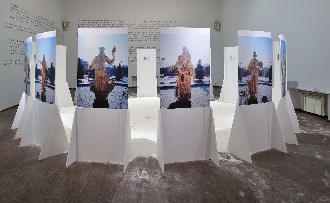Margarita Tupitsyn
Andrei Monastyrsky
Collective aesthetic practices long haunted Soviet art. Rooted in avantgarde artists’ commitment to serve the utopian project of Bolshevism, such forms of creativity were corrupted by socialist realism’s counterfeit of the image of successful collectivity, and hence challenged by post-war modernists eager to resurrect a lost sense of individuality. After the “bulldozer show” — the outdoor exhibition notoriously destroyed by Soviet authorities in 1974 — the next generation of unofficial artists once again flocked into collectives, this time as a survival tactic.
Andrei Monastyrsky’s exhibition traced the ins and outs of his relationship with collective aesthetics. Originally a poet, in 1975 he replaced his literary practice with a series of conceptual objects that he dubbed “elementary poetry.” These dadaist black boxes are effective in their visual and performative simplicity. They insist on the involvement of the viewer, who is instructed to perform basic acts such as looking into a tube, breathing into a box, and staring at his or her own finger sticking out of a hole. In this show, these solo works were hung near a corridor (reminiscent of the hallway in a communal apartment) in which eleven monitors screened performances by the Collective Actions group cofounded by Monastyrsky in 1976. The group’s members took turns conceiving laconic and incongruous scenarios, which they acted out together with a handful of other Moscow Conceptualists, almost always outside of the city. The videos effectively conveyed CA’s determination to catapult themselves out of the Soviet byt (everyday life) and engage in a laboratory procedure of analyzing and theorizing aesthetic practices that would thwart the desire to make commodifiable art objects.
The exhibition also included several substantial works that Monastyrsky has produced (including realizations or reconstructions of his 1970s projects) over the past decade and which are based, to a large degree, on CA’s performances or were inspired by dialogues with various Moscow Conceptualists. However, in each case Monastyrsky has built a structure of his personal sociocultural references on this collective foundation. Of particular significance the multimedia installation Shade of a Hare or 100 Years of Brentano, 2007, a Duchampian assemblage of anomalous objects and projected images (ranging from those depicting CA’s performances to portraits of German philosophers) that put the viewer within a frame of paradoxical associations.

Andrei Monastyrsky, Fountain, 1996, photographs mounted on sixteen boards, wheat flour, 7' 2" x 19' 8" x 19' 8".
Fountain, 1996, installed in a separate room, deals with the same topic as Monastyrsky’s 1986 text “VDNKh — The Capital of the World, a Schizoanalysis.” Starting in the late 1930s, VDNKh, the All-Russian Exhibition Center in Moscow, celebrated the success of the socialist economy. With the disintegration of the Soviet Union, it became a monument to the failed social utopia, or, to use Monastyrsky’s term, “a temple under the open skies.” Fountain is a re-creation of the VDNKh’s lavish Friendship of Nations fountain, with its circle of gilded figures. The interior floor of Monastyrsky’s version is covered in white flour, allegorizing VDNKh as the ground-down iconographic monolith with whose traces the audience’s soles contaminate the post-Soviet museum.
Throughout the exhibition, one encountered Monastyrsky’s selfportraits: videos of him blowing into one of his boxes or drawing on his body, an oversize photograph in which he kneels like a Taoist monk on the snow during CA’s 1983 performance Sound Perspectives, and so on. Together, these reminded viewers that Monastyrsky’s theo- retical mind and charismatic personality oiled the activities of the Moscow Conceptual circle for several decades. And yet, while wandering through a personal exhibition that included plenty of work produced or inspired by collective efforts, one could not avoid asking oneself whether it was legitimate to present such production under Monastyrsky’s name alone. In the Soviet context, keeping your name in the shadow of collective creativity was a canonical and sincere gesture. But as this production comes to feed the capitalist culture industry’s hunger for hyped-up superstars, the capitulation of collective production to individual authorship should not be taken for granted.
Margarita Tupitsyn, "Andrei Monastyrsky," Artforum, February 2011, pp. 247-248.
>KOLLEKTIVNYE DEYSTVIYA (COLLECTIVE ACTIONS). THE DESCRIPTIONS OF ALL THE ACTIONS, Photo and Video | BOCHUM ACTIONS [KD] | KD' PHONOGRAMS in mp3
Margarita Tupitsyn, About Early Soviet Conceptualism
